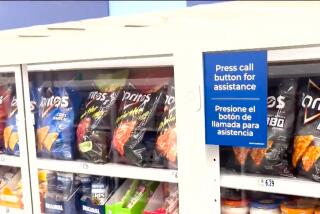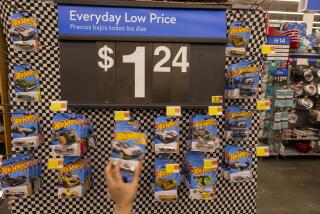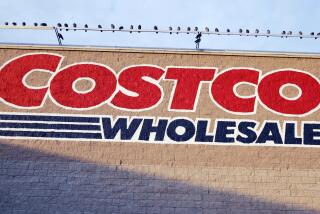To Catch a Thief : Retailers Employ High-Tech Weapons to Cut Billions in Shoplifting Losses
Here’s a vision of shopping worthy of “Star Trek”: Customer enters store, selects merchandise, puts it into bags, leaves store without opening wallet. No muss, no fuss. Radio waves automatically survey the price tags at the exit and debit the customer’s bank account.
And shoplifters don’t have a prayer. Those radio waves see right through a thief, detecting tags even on items concealed in a pocket or under a sweater.
But this is stuff of the 21st Century. In the here and now, retailers wage constant war against the legions that annually filch billions of dollars of merchandise.
“There are hordes of people out there every day nibbling away at retailers’ operations,” said Roger Griffin, vice president of Commercial Service Systems, a Van Nuys company that provides security services to retailers.
By generally accepted estimates, those nibbles add up to as much as $30 billion a year that merchants lose to shoplifters. But bolstered by technology, retailers have gone on the offensive with ever more sophisticated security personnel and anti-shoplifting devices.
Their weapons include guards who peer from inside decorative pillars, computer-controlled cameras that track shoppers from smoked-glass ceiling domes, ubiquitous large plastic tags on garments that set off alarms at exits and hair-thin wires on price tags pasted on consumer electronics gear. And recent indications are that many merchants are finally making a dent in this age-old problem.
‘Inventory Shrinkage’ Down
Bullock’s has installed $250,000 worth of smash-proof glass at its fine jewelry counters. May Co. has set up a bank of security monitors at a conspicuous location to make customers aware of increased scrutiny. Robinson’s has put locks on fitting room doors so that sales people can keep better track of garments. And Broadway has developed more sophisticated computer systems that track suspicious returns. Merchants are getting more hard-nosed about preventing shoplifting and, when that fails, prosecuting the perpetrators.
“Retailers have increased the amount of activity and effort spent in trying to control this problem,” said Stephanie Shern, a partner of the Arthur Young accounting firm and chairman of its retail services group.
In an annual survey of 115 retailers, the firm found that over the past year merchants slightly shaved losses to “inventory shrinkage,” a category that covers shoplifting, theft by employees and paper losses resulting from bookkeeping errors or fraud. The losses amounted to 1.7% of revenues, down from 1.8% of sales the year before.
And companies that make electronic article surveillance equipment--such as the big plastic tags on garments--say they have succeeded in cutting back shoplifting at many stores.
Merchants are up against not just drug addicts or the destitute or hard-core professionals, who account for perhaps 5% of all shoplifting.
“Traditionally, the industry has seen shoplifters as bad people, but it is often good people doing a bad thing,” said Edward A. Wolfe, vice president of loss prevention at Los Angeles-based Carter Hawley Hale Stores, parent of the Broadway department store chain.
Devising a profile of this criminal is easy. “The profile is everybody, and that’s the tragedy of it,” said Leif Lauritzen, executive director of the Stores Protective Assn., a 58-year-old cooperative of Los Angeles retailers that trains security personnel.
By Lauritzen’s estimate, a family of four in Los Angeles pays an extra $400 to $800 a year in higher prices as a result of retail theft.
Edgar S. Mangiafico, chairman of May Co. California, acknowledges the difficulty. “The truth is, we catch a small percentage of people who steal,” he said. “So I’m a lot better off if I can prevent it in the first place.”
As Mangiafico sees it, most amateur shoplifters simply get tempted. “It’s as if you were walking into a bank and that many dollar bills were displayed,” he said. “At least half of the people who steal that we catch have either the credit card or money on their person to have purchased that item.”
At the 34-store chain, inventory shrinkage costs between $6 million and $7 million each year, Mangiafico said. Of that, he estimated, theft by employees and customers accounts for about 60%, while 40% results from bookkeeping errors.
Lately, May Co. has been making its security efforts more obvious. For the past six months, the company has experimented with putting a bank of security monitors out in plain view on the selling floor of its Fox Hills Mall store. Although May Co. still uses the old standby--plainclothes detectives--it also is outfitting more security guards with blue jackets bearing “May Co. Security” patches.
“We’re moving swiftly toward high-profile security,” Mangiafico said, adding that the chain has started to encourage or reward employees who report shoplifting. The techniques appear to be working. Over the past four years, Mangiafico said, apprehension of shoplifters has dropped by as much as 20%--not because less is being stolen but because more crimes have been deterred.
On the other hand, the Broadway department store chain two years ago decided to get more subtle. Its D/tech system, made by ICI Americas in Valley Forge, Pa., is “100% concealed,” according to William C. Faulhaber, ICI’s business manager.
Security tags are still visible on the garments, but no gates or pedestals are apparent at the exits. Instead, the devices that sound an alarm if a customer tries to walk out without paying are hidden behind walls or ceilings.
Similarly, Neiman-Marcus, the pricey specialty store, uses a device called a Trojan horse, an eight-foot-tall pillar covered with smoked, “two-way-mirror” glass that even contains shelves laden with merchandise. From inside this portable device, security guards can watch customers without being seen.
Sensormatic, which developed the “Alligator” tags that set off an alarm if not removed before the customer leaves the store, also is in the closed-circuit television business. Cameras, housed within smoked-glass domes in store ceilings, can be programmed to zoom in on a cash drawer or to follow a customer.
“The cameras can walk a beat the way a guard would,” said Brad Kane, director of product management for the Deerfield Beach, Fla., company. In the United States, Sensormatic tag systems have been installed in 35,000 locations and camera systems in 15,000, including office buildings and factories.
For merchants, the trick is to devise ways to prevent theft without offending the vast majority of honest shoppers.
“In retailing, you want to sell, to welcome customers and embrace them,” said Gerald W. Klein, president of Checkpoint Systems, a Thorofare, N.J., company that makes security devices. “But retailers are overcoming this natural relationship they want to have with shoppers (because of) the realization that they’re being stolen blind.”
Still 15 or 20 years away is a system that will automatically ring up purchases and debit a customer’s account without the use of cash registers. In the meantime, Checkpoint is having limited success with disposable price labels including paper thin electronic circuits that can be deactivated at the register. One customer is Ralphs Grocery, which uses the system for items such as film, meats and cigarettes in 50 of its 128 stores. After paying, customers exit through a five-foot-high, chrome, looped antenna that detects whether any labels are still active.
Still Room for Growth
Electronic article surveillance companies “offer a tool to make a distasteful end of the business a little more palatable,” said Thomas A. Nicolette, vice president and general manager of Knogo. Knogo’s founder, Arthur Minasy, started the electronic article surveillance business 21 years ago, making the first electronic tag in his garage.
In addition to offering a radio-frequency system with reusable tags similar to Sensormatic’s, Knogo also sells a micromagnetic system using Chameleon, a hair-thin piece of metal that can be embedded in packaging or under a price label or included as part of the bar code markings.
Although there is still ample potential for installing systems in department and specialty stores, Nicolette sees the industry’s greatest growth coming in supermarkets and drugstores, well under 5% of which now have electronic article surveillance systems.
Tom Sour, an analyst with Gruntal & Co. in New York, estimates the industry’s annual sales at more than $200 million and sees them growing at 20% a year for several years to come.
For many retailers, particularly supermarkets and hardware and discount stores, profit margins are very thin, he noted. “If you lose a percentage point or two of stock, that’s equivalent to your profit, if any,” he said. “If you cut back on some (shoplifting), the profit margin will swing back very sharply.”
More to Read
Inside the business of entertainment
The Wide Shot brings you news, analysis and insights on everything from streaming wars to production — and what it all means for the future.
You may occasionally receive promotional content from the Los Angeles Times.











